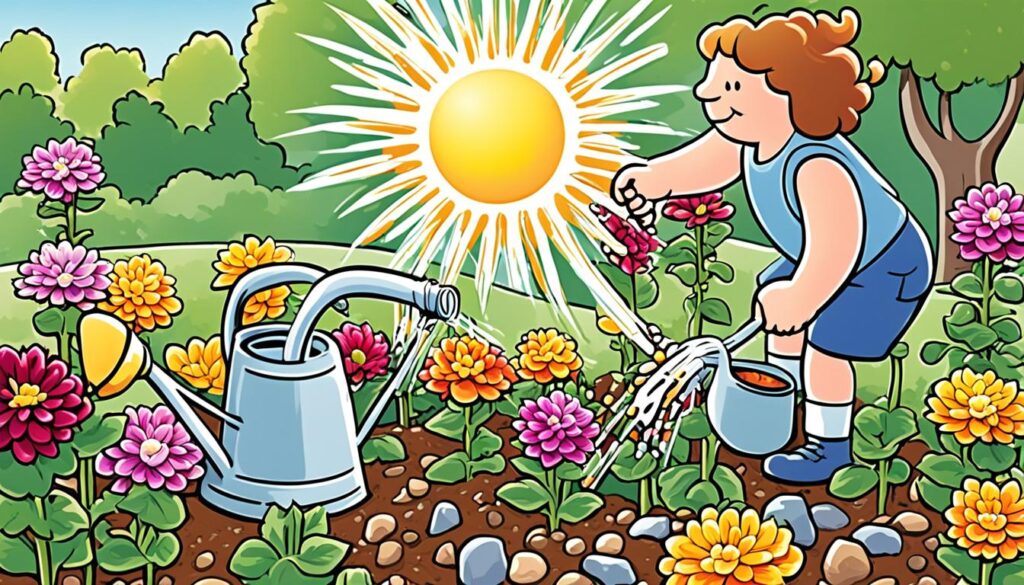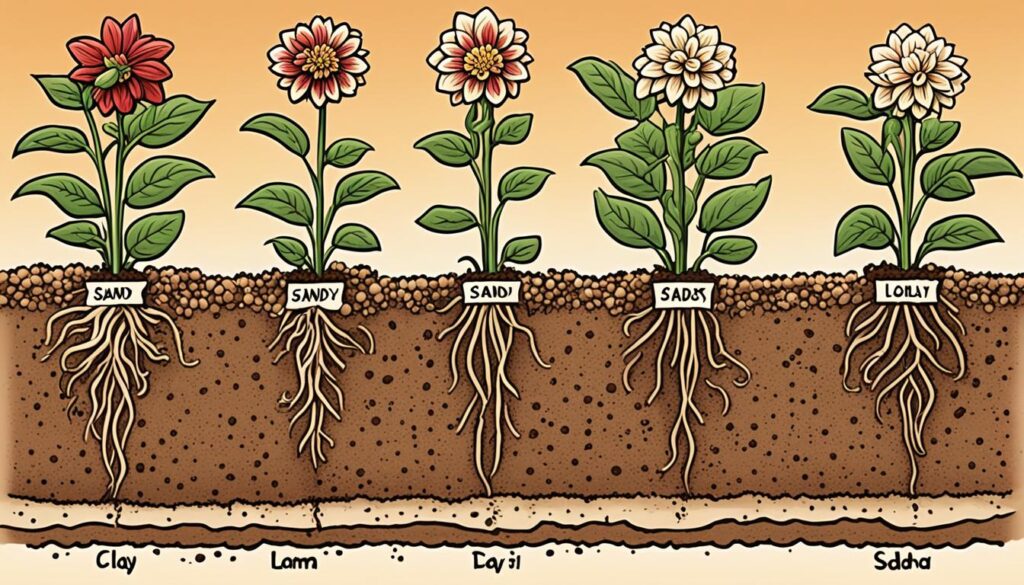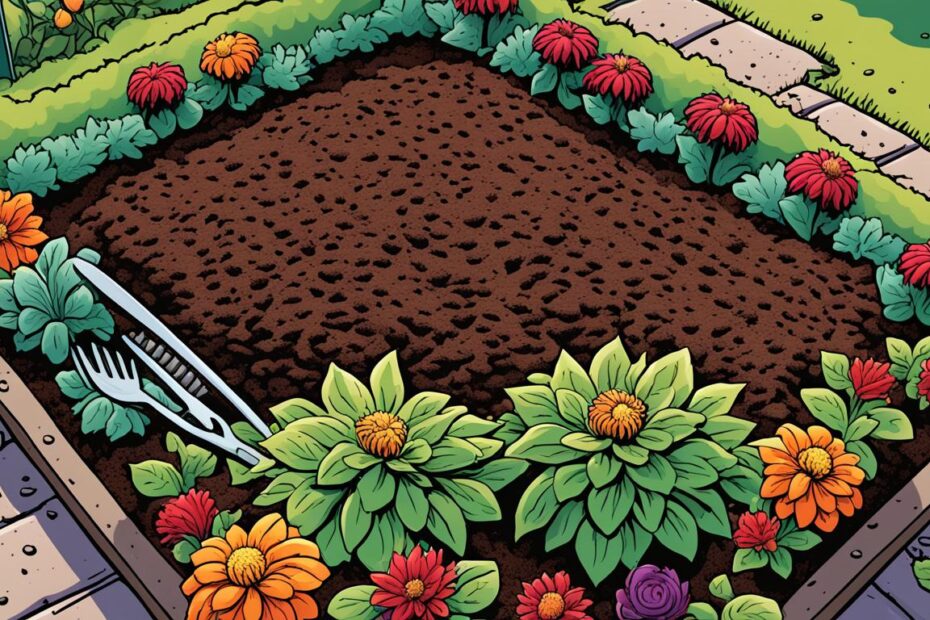Are you ready to take your gardening skills to the next level? If you’ve been dreaming of vibrant dahlias blooming in your garden, then it’s time to dive into the world of soil and discover what kind of soil dahlias truly thrive in. It turns out that these gorgeous flowers have specific soil preferences that can make all the difference in their growth and beauty. So, what kind of soil do dahlias like? Let’s uncover the secrets and unleash the full potential of your dahlia garden.
- Providing optimal soil conditions is crucial for the success of your dahlia garden.
- Dahlias prefer well-draining soil with plenty of organic matter.
- Clay soil, which retains too much moisture, is not suitable for dahlias.
- Preparing the soil by adding compost, peat moss, and organic fertilizer is essential.
- Plant dahlias after the last frost date when the soil temperature reaches 60 degrees Fahrenheit or higher.
Choosing and Planting Dahlias
When it comes to dahlias, there is a wide variety of types to choose from. From single dahlias with their elegant simplicity to extravagant dinner plate dahlias that boast large blooms, there is a dahlia for every garden. Some other popular types include orchid dahlias, with their intricate petal arrangements, and pom pom dahlias, which feature compact, rounded blooms. When selecting dahlias for your garden, consider their eventual size and the space available.
Planting dahlias is a straightforward process that requires attention to soil conditions and proper tuber placement. Dahlias thrive in full sun and fertile, well-draining soil. Before planting, make sure the soil is adequately prepared by incorporating organic matter such as compost or aged manure. This will provide the necessary nutrients and improve drainage.
As for the tubers, planting them correctly is essential for successful growth. Place the tubers in the ground with the eyes facing up, about 2-3 inches deep. Cover them with soil, ensuring they are securely nestled in their designated spot. For taller dahlia varieties, it is advisable to stake or cage the plants for support.
Here is a simple step-by-step guide to planting dahlias:
- Prepare the soil by amending it with organic matter.
- Select healthy tubers and place them in the ground with the eyes facing up.
- Cover the tubers with 2-3 inches of soil.
- Stake or cage the plants for support, especially taller varieties.
- Water the plants thoroughly after planting, and continue to water regularly.
- Fertilize the dahlias as per the recommended guidelines.
By following these planting tips and providing the ideal soil conditions, you can ensure that your dahlias flourish and bring beauty to your garden.
Different Types of Dahlias
| Type of Dahlia | Growth Habit | Bloom Size |
|---|---|---|
| Single Dahlia | Upright | Medium |
| Orchid Dahlia | Bushy | Large |
| Dinner Plate Dahlia | Upright | Extra Large |
| Pom Pom Dahlia | Compact | Small |
Caring for Dahlias
Proper care is essential for the health and vitality of your dahlias. By following these tips for watering, fertilizing, and preventing problems, you can ensure your dahlias thrive and bloom beautifully.
Watering Dahlias
Dahlias require consistent moisture to flourish, but it’s important to find the right balance. Overwatering can lead to root rot and other problems. Drip irrigation is the ideal method for watering dahlias, as it delivers water directly to the roots without wetting the foliage. If drip irrigation isn’t feasible for your garden, hand-watering deeply once or twice a week will suffice. Water the soil thoroughly, allowing it to dry slightly between watering sessions.
Fertilizing Dahlias
Proper fertilization is crucial for the growth and blooming of dahlias. A low-nitrogen fertilizer with a higher phosphorus content should be applied at planting time and during the blooming period. This encourages root development and enhances flower production. It’s important to avoid over-fertilization, as excessive nitrogen can result in lush foliage but fewer flowers. Additionally, it is crucial to stop fertilizing by early September to ensure proper tuber storage for the winter.
| Fertilizer Recommendation | Application Time | Rate |
|---|---|---|
| Fertilizer with higher phosphorus content | Planting time | 1 cup per 10 square feet |
| Fertilizer with higher phosphorus content | Beginning of blooming period | 1 cup per 10 square feet |
Preventing Problems
“An ounce of prevention is worth a pound of cure.”
To ensure the health and well-being of your dahlias, it’s important to take preventative measures against pests and diseases. Avoid chemical pesticides and herbicides that can harm beneficial insects and pollinators. Instead, opt for organic controls such as diatomaceous earth and neem oil, which effectively combat common pests like aphids and spider mites. Keep the foliage dry by watering at the base of the plant, as wet foliage can lead to fungal diseases. Regularly inspect your dahlias for signs of pests or diseases, and promptly remove any infected or damaged foliage. Deadhead and disbud spent flowers regularly to encourage new blooms and prevent disease and pest infestations.
With proper care and attention, your dahlias will reward you with stunning flowers and vibrant colors throughout the growing season.

Best Soil for Dahlias
When it comes to nurturing dahlias, choosing the right soil is crucial for their optimal growth and flourishing blooms. Dahlias thrive in well-drained soil that is rich in nutrients and organic matter. To ensure your dahlias have the perfect soil conditions, follow these essential tips:
Soil Fertility and Drainage
The foundation of a successful dahlia garden lies in fertile soil with excellent drainage. Well-drained soil allows water to flow through easily, preventing waterlogged roots and potential rotting. To improve drainage and promote root health, add plenty of organic matter, such as peat moss and compost, to your soil. These organic amendments not only enhance soil fertility but also help anchor the dahlia plants, providing a stable base for their growth.
Soil pH and Amendments
Dahlias prefer slightly acidic soil with a pH range of 6.3 to 6.8. It’s important to test the pH level of your soil before planting dahlias and make any necessary adjustments. If your soil’s pH is too high (alkaline), you can lower it by adding amendments such as elemental sulfur or organic matter like pine needles. On the other hand, if your soil is too acidic, you can raise the pH by adding lime or wood ashes. Finding the ideal soil pH for your dahlias will ensure they can absorb nutrients effectively and thrive.
Nutrients for Dahlias
Dahlias have specific nutrient needs for healthy growth and abundant blooms. They require low nitrogen and high phosphorus levels in their fertilizer. The higher phosphorus content promotes robust root development, flower production, and overall plant health. Fertilizers with a ratio of 5-10-10 or 10-20-20 are ideal for dahlias. Another natural source of phosphorus is bone meal, which can be added to the soil before planting the dahlias.
Here’s a table summarizing the essential soil requirements for dahlias:
| Soil Aspect | Recommendation |
|---|---|
| Soil type | Well-drained soil with plenty of organic matter |
| Soil pH | Slightly acidic, with a range of 6.3 to 6.8 |
| Nutrients | Fertilizers with low nitrogen and high phosphorus levels |
By providing the best soil conditions for your dahlias, you’ll create an environment where they can thrive and produce stunning blooms. Remember to test your soil, ensure it is well-drained, adjust the pH if necessary, and provide the right nutrients. These soil considerations will set the stage for a successful dahlia garden.
Soil Types and Planting Tips
When it comes to growing dahlias, it’s essential to consider the specific requirements of different soil types. Sandy soil and clay soil both require distinct preparation techniques to create the optimal growing conditions for your dahlias. Understanding the characteristics of each soil type and implementing the appropriate amendments can make a significant difference in the success of your dahlia garden.
Sandy Soil:
If you have sandy soil, which tends to drain quickly and lacks water retention, incorporating organic matter is key. Adding homemade compost, decayed leaf matter, and organic manure can significantly improve both fertility and water retention in sandy soil. These amendments help retain moisture, promote nutrient availability, and create a more balanced growing environment for your dahlias.
Clay Soil:
On the other hand, if you have clay soil, which tends to retain excessive moisture and has poor drainage, it’s important to take steps to lighten and improve its drainage capabilities. Mixing in drainage amendments such as peat moss and sand can help break up the heavy texture of clay soil and provide better drainage for your dahlias. By improving the soil structure, you can prevent waterlogging and create a more favorable environment for root development and overall plant health.
Mulching:
In addition to soil preparation, mulching is a valuable practice for all soil types when growing dahlias. Applying a layer of mulch around the base of the plants helps reduce moisture loss from the soil and maintain a more consistent soil temperature. Mulching also acts as a natural weed suppressant and helps prevent soil erosion. Organic materials such as straw, wood chips, or shredded leaves make excellent mulch choices for dahlias.
Remember, before planting dahlias, it’s important to test the soil to determine its nutrient content and overall suitability for dahlia cultivation. Soil testing can help you identify any deficiencies and allow you to amend the soil accordingly to ensure your dahlias receive the necessary nutrients for healthy growth and vibrant blooms.

| Soil Type | Characteristics | Preparation Techniques |
|---|---|---|
| Sandy Soil | Drains quickly, lacks water retention | 1. Add homemade compost 2. Incorporate decayed leaf matter 3. Apply organic manure |
| Clay Soil | Retains excessive moisture, poor drainage | 1. Mix in peat moss 2. Add sand for improved drainage |
Conclusion
Growing dahlias successfully starts with providing optimal soil conditions. These vibrant and versatile flowers come in a wide variety of types and colors, making them a beautiful addition to any garden. With proper care and maintenance, including regular watering, fertilizing, and pest control, dahlias can thrive and produce abundant blooms.
To ensure the health and vitality of your dahlias, it is crucial to prepare the soil correctly. Choose a well-draining soil that is rich in organic matter, such as compost and peat moss, to provide the necessary nutrients. Remember that dahlias prefer slightly acidic soil with a pH range of 6.3 to 6.8, so it’s important to test and amend the soil if needed.
In addition to soil preparation, selecting the right varieties and following proper planting techniques are essential for successful dahlia gardening. Consider the space available in your garden and the ultimate size of the dahlias you choose. Plant them in full sun and stake or cage taller varieties to support their growth. Regular watering, fertilization, and pest control measures will help maintain the health of your dahlias throughout the growing season.
By providing optimal soil conditions, choosing the right varieties, and practicing proper care and maintenance, you can enjoy the beauty and abundance of dahlias in your garden for months to come. So, roll up your sleeves, get your hands dirty, and watch your dahlias dazzle in your garden. Remember, healthy soil equals healthy plants, and with a little love and attention, your dahlias will reward you with a breathtaking display of colors and blooms.
FAQ
What kind of soil do dahlias like?
Dahlias prefer well-draining soil with plenty of organic matter and a slightly acidic pH level. Clay soil, which retains too much moisture, is not suitable for dahlias. It’s important to prepare the soil before planting by adding compost, peat moss, and organic fertilizer to provide the necessary nutrients.
What are the different types of dahlias and how do I choose which ones to grow?
There are various types of dahlias with different growth habits and bloom sizes, such as single dahlias, orchid dahlias, dinner plate dahlias, and pom pom dahlias. When choosing which dahlias to grow, it’s important to consider their eventual size and the space available in your garden. Dahlias should be planted in full sun and fertile, well-draining soil.
How should I water and fertilize my dahlias?
Dahlias need regular watering to keep the soil consistently moist but not waterlogged. Drip irrigation is ideal, but hand-watering can be done deeply once or twice a week. Fertilizing dahlias is important, and a low-nitrogen fertilizer with higher phosphorus content should be applied at planting time and during the blooming period. It’s important to avoid over-fertilization and to stop fertilizing by early September to ensure proper tuber storage.
How can I prevent pests and diseases in my dahlia garden?
Controlling pests and diseases can be achieved by avoiding chemical pesticides and herbicides, keeping the foliage dry, and using organic controls such as diatomaceous earth and neem oil. Regular deadheading and disbudding of spent flowers can encourage new blooms and control pests and disease.
What is the best soil for growing dahlias?
Soil fertility is crucial for optimal growth of dahlias. Well-drained soil with plenty of organic matter, such as peat moss and compost, is important for providing nutrients and anchoring the plants. Dahlias prefer slightly acidic soil with a pH range of 6.3 to 6.8. Clay soil should be amended with drainage materials to prevent waterlogging. Dahlias require low nitrogen and high phosphorus nutrients, so fertilizers with these ratios or the addition of bone meal can be beneficial.
What are the best planting tips for different soil types?
Different soil types require specific preparation techniques for growing dahlias. Sandy soil needs the addition of homemade compost, decayed leaf matter, and organic manure to improve fertility and water retention. Clay soil requires drainage amendments, such as peat moss and sand, to lighten the soil and provide better drainage for the dahlias. Mulching can be done around the base of the plants to reduce moisture loss and maintain soil temperature.
How can I ensure successful dahlia gardening?
Growing dahlias successfully starts with providing optimal soil conditions. With proper care and maintenance, including regular watering, fertilizing, and pest control, dahlias can thrive and produce abundant blooms. By preparing the soil correctly, choosing the right varieties, and following proper planting techniques, you can enjoy the beauty of dahlias in your garden for months to come.
